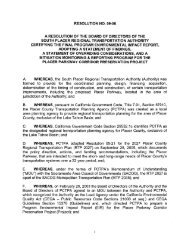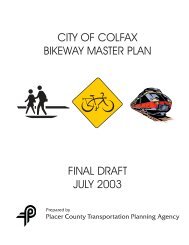Bus Rapid Transit (BRT) Implementation Study for South ... - pctpa
Bus Rapid Transit (BRT) Implementation Study for South ... - pctpa
Bus Rapid Transit (BRT) Implementation Study for South ... - pctpa
Create successful ePaper yourself
Turn your PDF publications into a flip-book with our unique Google optimized e-Paper software.
<strong>Bus</strong> <strong>Rapid</strong> <strong>Transit</strong> (<strong>BRT</strong>) <strong>Implementation</strong> <strong>Study</strong> <strong>for</strong> south Placer CountySeptember 8, 2006Class II running ways provide exclusive transit lanes that areseparated from the street right-of-way. They provide partial accesscontrol, allowing enhanced but not uninterrupted flow <strong>for</strong> the transitvehicles. An at-grade busway is a typical example of a Class IIrunning way. Because the Class II running ways physicallyseparate <strong>BRT</strong> vehicles from the general stream of traffic, they canguarantee travel times and reliability. However, Class II runningways have to interact with other traffic at cross streets.Class III running ways are physically separated lanes within streetright-of-way, such as arterial median busways and bus streets.Although median arterial busways are physically segregated fromadjacent street traffic lanes, Class III running ways are sometimesused by streetcars and LRT.Class IV running ways are exclusive or semi-exclusive lanes, suchas concurrent and contra flow bus lanes, located within street rightof-way.Class IV running ways are set aside as a designatedarterial lane <strong>for</strong> <strong>BRT</strong> vehicles only. However, in some cases,specified classes of vehicles are allowed to share the designatedlane such as turning vehicles or high-occupancy vehicles.Class V running ways are characterized by mixed traffic operations,where lanes are shared. The running ways have no control ofaccess, such as mixed traffic lanes. Mixed flow lanes are the mostbasic <strong>for</strong>m of Class V running way. Most rubber tired urban transitservice operates on mixed flow lanes. Because other vehiclesshare the same lane as <strong>BRT</strong> vehicles, <strong>BRT</strong> vehicles face delays dueto conflicts with other vehicles.4





